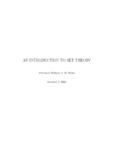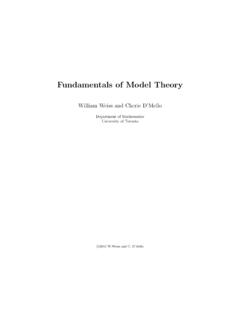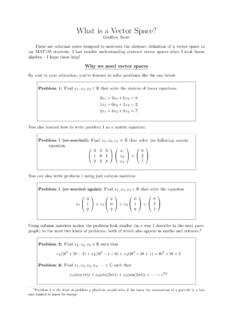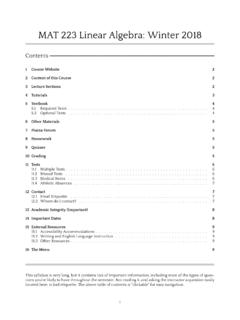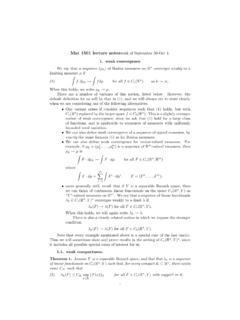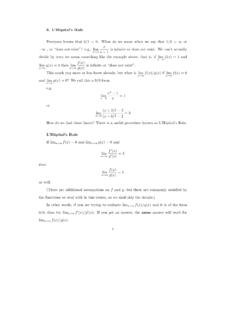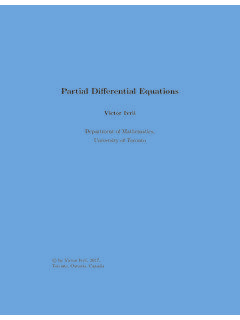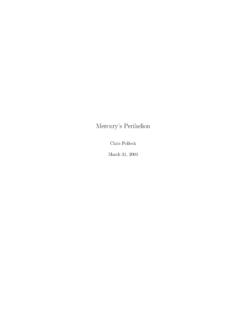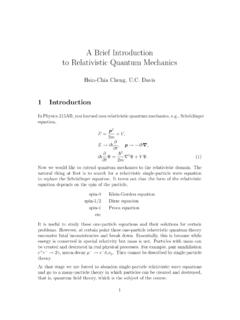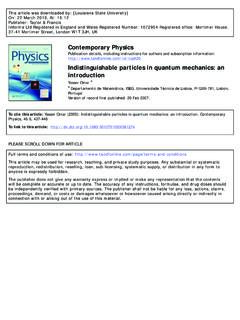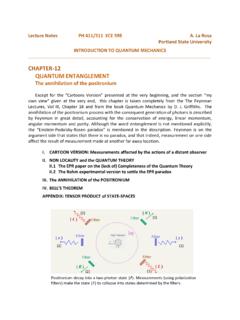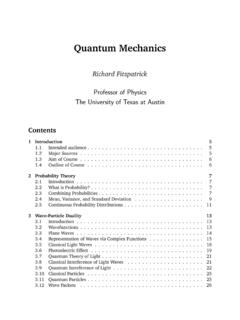Transcription of INTRODUCTION TO RELATIVISTIC QUANTUM …
1 INTRODUCTION TO RELATIVISTIC QUANTUM MECHANICSAND THE DIRAC EQUATIONJACOB E. development of QUANTUM mechanics is presented from a his-torical perspective. The principles of special relativity are reviewed. Relativis-tic QUANTUM mechanics is developed, including the Klein-Gordon equation andup to the Dirac the end of the 19th century, physicists were confident in their view ofthe world. Newton s mechanics had explained the dynamics of everything from theheavenly bodies down to rubber balls. Maxwell s equations of electromagnetism hadsuccessfully unified the seemingly different phenomena of electricity, magnetism,and light. Although there remained some unresolved questions, most physicists wereconfident that these would soon be solved, within the well-understood frameworkof the time.
2 They were the early twentieth century, the development of two new theories drasticallyaltered the way that physicists view the universe and everything in it. Quantummechanics and relativity theory changed the fundamental framework of all futurephysical theories, putting the lie to previous notions of absolute velocity or length,and precise knowledge of momentum or by countless experiments, and verified under widely ranging condi-tions, special relativity (SR) and QUANTUM mechanics (QM) have proven very usefultheories for predicting physical phenomena. Unfortunately, as it was first under-stood, QUANTUM mechanics was incompatible with special relativity. In this paperI intend to summarize the development of non- RELATIVISTIC QM, review the relevantfeatures of SR, and document two attempts to consolidate QM to the frameworkof assume the reader is comfortable with non- RELATIVISTIC QM, and has been ex-posed to the basics of SR.
3 I hope the reader will come away with a basic under-standing of the development of RELATIVISTIC QUANTUM mechanics , up to and includingthe Dirac equation. In order to maintain the flow of the narrative, I have relegatedthe proofs of certain results to Appendix this article I will employ the Einstein summation convention, wherebyrepeated indices in a term are summed over all their values. Greek letters ( , )are summed over = 0,1,2,3, and Latin letters ( ,j,k) are summed overi= 1,2, : April 12, E. QUANTUM MechanicsIn 1900, constrained by a classical framework, physicists had been unable toexplain the observed blackbody spectrum. Max Planck recognized that he coulddo away with the problem by assuming that atoms emit radiation only in discretepackets with specific energies.
4 If the energyEof each packet was related to theangular frequency of the radiation by(1)E=~ then the observed spectrum could be explained. Equation (1) is known as Planck srelation, andh= 2 ~is Planck s constant,h 10 34J 1905, Albert Einstein used Planck s ideas to explain the puzzling photoelectriceffect, when he made the further assumption thatallelectromagnetic radiationcomes in packets (or photons ), obeying the Planck relation (1). In the sameyear, Einstein would revolutionize physical thinking about time and space with hisspecial theory of relativity, to be discussed 1923, Louis de Broglie proposed that a material particle should have somesort of wave associated with it. Using (1) in the context of special relativity, hederived his relation(2)~p=~~k,where~pis the momentum of the particle and~kis the wave vector of the associatedwave.
5 The dual particle-wave nature of light and matter were slowly becoming clear:Planck associated particle-like properties to light waves, and de Broglie associatedwave-like properties to Schr odinger discovered the differential equation governing de Broglie s matter waves , and laid down the framework for the extremely successful theoryof QUANTUM mechanics . Schr odinger postulated that the state of a particle of massmought to be described by a complex-valued function (t,~x), varying in time de Broglie, Schr odinger considered a plane wave function,(3) (~x,t) =e i( t ~k ~x).He noted that, differentiating with respect to time, t= i e i( t ~k ~x).Upon multiplying both sides byi~and applying Planck s relation (1),i~ t=~ =E .This motivated Schr odinger to consider the energy operator on wave functions,(4)Eop=i~ twhose value on a plane wave is the energy of the photon, as given by , taking the gradient of both sides of (3), multiplying both sides by i~,and using the de Broglie relation (2), we have i~ =~~k =~p , RELATIVISTIC QUANTUM MECHANICS3which leads us to define the momentum operator(5)~Pop= i~ ,whose value on a plane wave is its momentum, as given by de classical energy of an unconstrained particle of massmis(6)E=|~p| odinger replaced the classical energyEand momentum~pin (6) by the waveoperators introduced above in (4) and (5), to obtain(7)
6 Eop= ~Pop we substitute the definitions of the wave operators, and apply both sides to thematter wave function , we obtain(SE)i~ t= ~22m 2 This is thefree particle Schr odinger equation, and it is the basis of non-relativisticquantum mechanics . Its solutions (~x,t) describe the states of plethora of experiments in many diverse contexts have validated (SE), andmuch of modern technology is based on the QUANTUM mechanical theory of whichit is the basis. However, as we will later see, Schr odinger s formulation of QM isinconsistent with Einstein s special relativity, and we must seek a relativisticallycovariant equation to reconcile the RelativityIn 1905, Albert Einstein proposed the theory of special relativity (SR), revo-lutionizing the field of physics.
7 Motivated by the observation of Michelson andMorley in 1887 that the speed of light in vacuumcis independent of any motion ofan observer, Einstein postulated the following axiom:Axiom 1.(Relativity Principle) All inertial observers observe the same laws ofphysics. In particular, all inertial observers observe the same speed of lightc, withc 108 reformulated Einstein s ideas in a geometric way, and this is theapproach that I will set of all events is calledspacetime, and is denotedM. In special relativity,we assume thatMhas the manifold structure ofR4. We further assume that thereexists a class of preferred observers in spacetime, calledinertial observers, andthat inertial observers can label each eventx Mby cartesian coordinates:x=(x0,x1,x2,x3), with the time component ofxbeingt=x0/c, and the position is~x= (x1,x2,x3).
8 Such a labelling of spacetime is called aninertial coordinatesystem. The coordinate systems of different observers are related by the elementsof the 10-parameter Poincar e group, consisting of the Lorentz transformations andthe E. SONEWe define themetric of spacetime , a 2-form, by(8) ab= (dx )a(dx )b,where =diag(1, 1, 1, 1),and{x }is any inertial coordinate system. It isa consequence of Axiom 1 that is a tensor, is independent of the choice ofcoordinates. If we write out the action of on two vectorsxa,yb M, we have (x,y) = abxayb=x0y0 x1y1 x2y2 x3y3=x0y0 ~x ~ can view particles in spacetime as tracing out a curve inMas time relativity asserts that the paths of material particles aretimelikecurves,that is(9) abTaTb>0,whereTais the tangent vector to the curve.
9 We can parametrize timelike curvesby theproper time , defined so that abTaTb=c2everywhere along the curve. measures the time elapsed on a clock carried along the given curve a timelike curve, denotedUa, is the tangent vector to the curvewhen it is parametrized by proper time. In particular,(10) abUaUb= particles have an invariant quantity called therest mass,m, which is themass of the particle as measured by an observer at rest with respect to the a particle with massmis defined as(11)pa=mUa,a relativistically covariant vector. Direct substitution and (10) yields the followingrelation:(12) (p,p) = abpapb= ab(mUa)(mUb) =m2( abUaUb) = energy of a particle in special relativity depends on the motion of the observerwho measures the energy.
10 If a particle with 4-momentumpais measured by anobserver with 4-velocityVa, theenergyof the particle is defined as(13)E= (p,V) = a static observer with 4-velocityV= (c,0,0,0), the energy isE= (V,p) =cp0. Now, (12) gives (p,p) = (p0)2 |~p|2= , we obtain(14)E=cp0=c(|~p|2+m2c2)1/2,the important equation relating RELATIVISTIC momentum and Klein-Gordon EquationNow that we have some understanding of the principles of special relativity, itis clear that the Schr odinger equation (SE) is not suitable for the new relativisticcontext. Indeed, it is manifest that (SE) is not relativistically covariant; the deriv-ative in the time coordinate is first order, while the derivatives with respect to thespacial coordinates are all second order.
